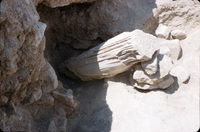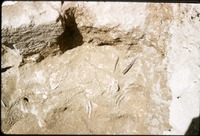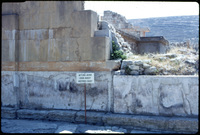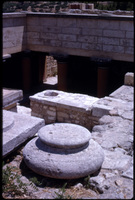-

Knossos excavation, statue
-

Seven excavators work at the Royal Road excavations at Knossos. Using shovels they remove dirt around an outer wall. This is the beginning of a new trench (topsoil).
-

A pot is being removed from what a well (Well III) at Knossos. Four people are participating in its removal. This is a part of the Royal Road excavations.
-

A series of tables are set outside a taverna used as an excavation headquarters just outside of Knossos. One person sorting pottery is pictured.
-

It is an image of the Royal Road excavation at Knossos, with 15 excavators. This image features a several partially collapsed walls and a large block.
-

This is a scan of part of a newspaper article titled "The Truth about Knossos." The article claims that the excavation at Knossos is one of the most, if not the most, important excavation of the 20th century. The article, written by RL Palmer, explains that the findings were missinterpreted, as they were archived as they were discovered.
-

A bust of Sir Arthur Evans is depicted.
-

This is an excavation image of painted plaster in situ in the Royal Road excavations. The photograph includes an excavation knife for scale and to indicate north. The plaster has black lines painted onto a white ground.
-

This is an image of an excavator in 1961 as part of the Royal Road excavations at Knossos. He is in the process of uncovering preserved plaster, kneeling on one knee and pulling back a cloth which is covering part of the plaster. Part of the plaster is being conserved, as can be seen from the fresh plaster covering it.
-

This image is of a collapsed wall with dirt and rubble behind it. It is the west facade of the palace at Knossos, including portions reconstructed by Sir Arthur Evans. A sign in the center of the image, in front of the wall, reads "Western Court" in Greek, French, and English.
-

This image depicts the drain from the East Bastion at Knossos.
-

This image depicts the stairs from the East Bastion. In total, there are five steps that lead to another stairwell.
-

This image depicts part of a room in a palace that includes a chair/throne two pieces of decor hanging on the walls and support columns that also serve as an extrance/exit to the room.
-

This frieze shows dolphins and other marine life. Only two of the dolphins were preserved, so the other have been reconstructed. Some other details are spiral decoration motifs on the walls and rosettes, painted to indicate that the rosettes replaced the spirals in the painting.
-

This is a photograph of the Grand Staircase at Knossos, specifically the open portion in the center called a light well. A column base is visible in the center foreground of the image. The stairs are not visible, and the lower room is in shadow. A doorway can be seen in the lower room, and Minoan-style columns support the roof.
-

This is a photograph of the so-called Royal Temple Tomb at Knossos. Horns of consecration appear in the foreground. In the middle ground, a modern stone pathway descends out of sight. In the background, the subject of the photograph appears - the Royal Temple Tomb, a two-storied rock cut chamber tomb. The visible area is the antechamber of the upper floor, with two columns supporting a roof.
-

This is an image of the archaeological site at the palace of Knossos.
-

This is an image of a terracotta simplified female figure from the hips up. Her arms are raised. She wears a crown of some sort on her head. Her breasts and hips are exaggerated and she has a very small waist.
-

This is a black and white image of an gold ovular object, the seal portion of a seal ring. There are 3 female figures decorating the object; the 2 on the left are standing while the one on the right is seated. To the right of the seated woman, there is a tree.
-

This is an image of the south entrance at Knossos, otherwise known as the South Propylaeum. The entrance is higher than the camera so the main building is only partially visible, but the steps, walls, columns, Procession Fresco, and horns of consecration are visible.
-

This is a slightly cropped, blue metal image of "The Minotaur" by George Frederic Watts. The minotaur gazes out into the see clutching something in his human hands.
-

Reconstruction of Central Court at Knossos
-

This is a modern interpretation (and likely a dramatization) of the Minoan ritual of bull jumping. Depiction by artist Rudolph Zallinger.
-

This is an image from the Palace of Minos, the excavation report on Knossos by Sir Arthur Evans. On the back of a crystal plaque a red bull has been rendered in the classic "flying gallop" style that was used in the Minoan period to ellucidate something in motion. The larger image that this was once a part of may have depicted a Minoan ritual of bull jumping. The bull is articulated as a single mass. Distinctive muscle bulges or deliniation of the neck area is not found.
-

This image is of the Cup Bearer Fresco at the South entrance of Knossos. The restored ancient building has bright white columns that hold up a section of a roof with both stone work and bright Frescoes behind them. Under the Fresco is a vessel and around the partial building is unrestored ancient ruins.
























